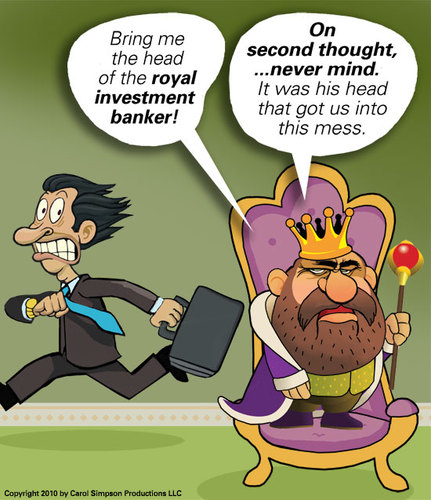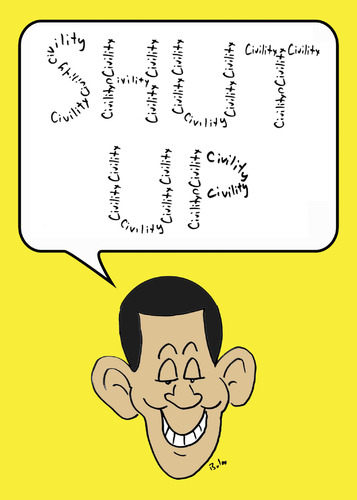In part one I talked to conservative cartoonist Rex May and learned about the different factions in American conservativism. This week, I interviewed Bob Simpson from Illinois who runs an agency called Design Works providing political cartoons for labor unions together with his partner Estelle Carol.
 Bob, you and Estelle cooperate on the cartoons … How does that work?
Bob, you and Estelle cooperate on the cartoons … How does that work?
I generally come up with the gags. I keep notes in a word processor and jot things down until a gag starts to shape up. I then edit and write a short description of what I think it should look like. Then I give it to Estelle.
Estelle is the visual artist, so working at her computer with an electronic drawing tablet she tries to improve upon the original concept. She edits dialog and layout. We confer about any further changes and when we agree, the cartoon is done. Since everything is electronic, it’s easy to make last minute changes.
What function would you say do your political cartoons fulfill?
 Most of our work is aimed directly at publication by the labor movement although we are picked up by business and alternative outlets as well. We believe that a strong democratic labor movement is essential to a civilized society.
Most of our work is aimed directly at publication by the labor movement although we are picked up by business and alternative outlets as well. We believe that a strong democratic labor movement is essential to a civilized society.
We see ourselves as exposing economic and social injustices in a direct humorous way. We hope that this encourages working class people to think more deeply about their situation. Here in the USA, the labor movement is in pretty bad shape, so we also hope that our cartoons are morale boosters for labor activists in these difficult times.
How come you as owners of a private business are actively supporting organized labor?
Both of us have worked for large educational institutions. Estelle as a graphic designer at a university and myself as a high school teacher. Here in the USA the labor movement was responsible for most of the limited social legislation that we have. Today it is fighting to defend that legislation and advance it where it can – in the face of powerful and well-funded opposition.
As a small business, we are painfully aware that an impoverished working class cannot support the many small businesses that depend heavily on working class prosperity. The empty store fronts and offices here in the Chicago metropolitan area are a testament to that reality.
 What other cartoons do you follow? Are there any conservative ones among them?
What other cartoons do you follow? Are there any conservative ones among them?
Among our favorite cartoonists on the Left are Clay Bennett, Gary Huck, Gary Trudeau, and Jen Sorensen. Our favorite ones on the Right are Henry Payne, Michael Ramirez, and Mike Lester.
What do you like about those right-leaning cartoonists? Is there some common ground?
An intelligent conservative movement is important to maintaining a balance in society. Conservatives who uphold the values of individual freedom can play an important role in defending those freedoms.
Left-wing governments can make stupid mistakes. Left-wing politicians can be enticed by corruption. Left-wing movements are after all made up of very fallible human beings and it is often hard to admit one’s own weaknesses. To the extent that conservative cartoonists expose and ridicule these failings, we need them.
Do you see any dangers in cartoonists’ partisanship – for example it contributing to a division of American society?
The divisions in US society are deeply rooted in our social class structure as well as our racial and gender caste system. Papering over these very real divisions will not make them go away.
With that said, cartoonists who stoop to exploiting these divisions rather than using their satire to heal them are doing us all a disservice. There is an old saying in the US newspaper industry that journalism should “afflict the comfortable and comfort the afflicted.” We stand by that old fashioned idea.
Thanks for your time!
]]>
Editorial cartoons are a part of political discourse. Some express liberal opinions, some are more conservative. Some cartoons criticize very specific shortcomings, some have a broader approach, some are clever, some border on propaganda. And so on. This is true for all democratic countries. In this interview – actually the first part of another “special” – I tried to find out more about how cartoonists see their own role in the political discussion.
In the United States the division between the liberal and conservative “camps” has become particularly visible in the last few years. This is at least partly an effect of the sales strategies of media outlets like Fox News or its liberal counterpart MSNBC. While toonpool.com has “left-leaning” members from a number of countries, the most vocal “conservatives” are/were Americans (RIP Joel Barbee). Since I wanted to talk to a liberal and a conservative from the same country, both my interviewees are based in the USA. National particularities like “paleoconservativism” left aside (read the interview to learn about this concept), I don’t think that they are much different from cartoonists from other countries.
Rex May, aka Baloo, is from Fort Collins, Colorado. He is a very productive cartoonist and has been working in the business since 1973. He is a vocal conservative, too.
 Rex, you do both political cartoons and “gag” cartoons. And, judging from input on toonpool.com, a lot of both. How many cartoons do you draw per day?
Rex, you do both political cartoons and “gag” cartoons. And, judging from input on toonpool.com, a lot of both. How many cartoons do you draw per day?
I draw at least twenty-five per week, usually more.
Do you prefer the political ones to the “gag” type?
Yes, a little, but of course they’re harder to sell.
What is it that makes political cartoons more interesting?
 I suppose it’s because they’re more immediate. It’s much the same thing for me as reading political blogs and columns. It’s just another way to disseminate political and social facts and opinions.
I suppose it’s because they’re more immediate. It’s much the same thing for me as reading political blogs and columns. It’s just another way to disseminate political and social facts and opinions.
What function would you say do your political cartoons fulfill?
I try to express the paleoconservative point of view in cartoon form, which is rather rare these days in cartoons and everywhere else.
Can you tell me a bit more about your paleoconservativism? Would you say that it is something different from the current Tea Party discourse?
Sure. The Tea Party groups are really diverse in their thinking. They include neocons, paleocons, libertarians, and other types as well. Paleoconservatism is what conservatism was before the neocon takeover of the Republican party.
Paleocons believe in minimal government and are reluctant to intervene abroad. They want no social engineering from the government and want actual adherence to the Constitution. They are opposed to gun control and prefer government action to take place at the local and state level whenever possible. Most are immigration restrictionists.
The neocons use a lot of conservative rhetoric, but believe in a lot of intervention abroad, and big government and, basically, the whole liberal agenda.
 You’ve been working as a cartoonist since the 1970s. Is there, in your opinion, a current increase in partisanship in American media and the population?
You’ve been working as a cartoonist since the 1970s. Is there, in your opinion, a current increase in partisanship in American media and the population?
The prevalent ideology has changed by moving steadily to the left. What passes for ‘conservative’ positions today would have been considered liberal fifty years ago.
There is a bit of a paleocon revolt, because of the Tea Party movement, and there is now much more of a push for closing borders and adhering to the Constitution. Whether it keeps going or not is the question. The leading Republicans and Democrats differ hardly at all, and their ‘disagreements’ are mostly just rhetorical.
Do you think that political cartoons play a part in this?
I don’t think they influence people much, but they do reflect what people are thinking to some extent, so editorial cartoons are more of a result than a cause of political changes.
Do you follow other conservative political cartoons? And .. more interesting to me .. do you follow any liberal cartoons?
Sure, kind of randomly. I look at political cartoons regularly at Daryl Cagle’s website and of course most of them are liberal.
 Do you think that some of the liberal political cartoons are funny? Is there some common ground?
Do you think that some of the liberal political cartoons are funny? Is there some common ground?
Sure. Many are funny even when I disagree with them. And of course I frequently agree with their opinions — especially the ones critical of foreign intervention — though liberals are often right for the wrong reasons, in my opinion.
Do you know any liberal cartoonists personally?
I’ve met very few other cartoonists in person because they tend to clump on the coasts and here I am in the Rocky Mountains, but I know a lot of them on the net, and have worked with lots of them — I’m also a gag writer, and I collaborate with cartoonists of just about every political persuasion. Cartoonists tend to be more liberal than other people, probably because artsy people in general tend to be.
Thanks for your time!
The second part of this special will be an interview with Bob Simpson who, together with Estelle Carol, creates cartoons for the American labor movement.
]]>